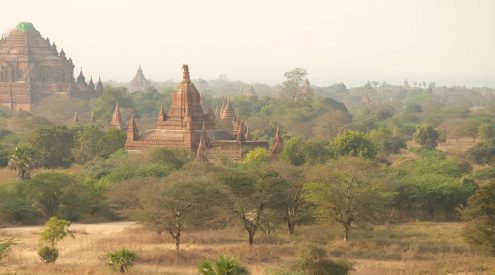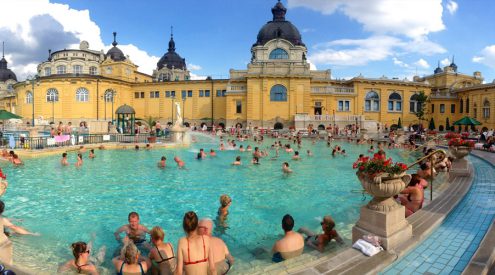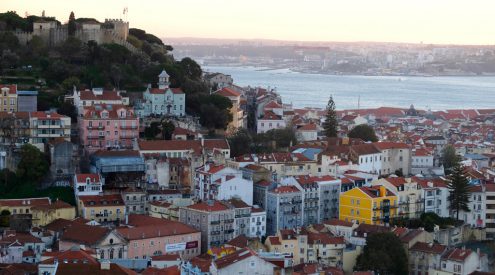Every year between 6 and 14 July, throngs of people clad in white pants and red scarves descend on the Spanish city of Pamplona to take part in the annual San Fermin Festival in honour of the San Fermin, the patron saint of Navarro. The eight-day celebration includes street parties, featuring gigantes (huge papier-mâché puppet figures managed from the inside) and bullfighting.
The main attraction is, of course, the Running of the Bulls, or Bull Run (known in Spanish as the Encierro). It is held at 08h00 every morning from the second day of celebrations (i.e. 7 July to 14 July). After two rocket shots, 12 Miura bulls charge through the streets of Pamplona for 875 metres from the Calle Santo Domingo corral to the bullring, where they will be killed. Every year, the streets swarm with adrenaline-seeking festival-goers who take part in the run.
Carnage on the Bull Run
As expected, testosterone-filled bulls cannot gallop through a swarm without horning and stepping on those who stand in their way. Every year there are injuries. This year, 23 people were maimed. One of these was a 23-year old Australian lady who, according to Euronews.com, had to undergo surgery for fractured ribs and damage to the right lung after being gored in the chest.
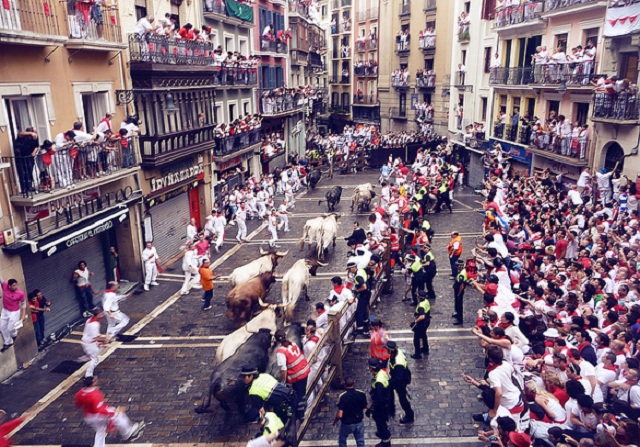
Crowds at the San Fermin Fiesta Encierre, Pamplona, Spain.
Before we point fingers and start asking questions, let’s at least take a look at the history of the event. According to Spanish travel website Spanish Fiestas, the Bull Run started in the thirteenth century and coincided with the San Fermin celebrations in October. Somehow, by the end of the fourteenth century the two festivals had fused into one large religious event filled with music and dance in Pamplona. The city council moved the event to July because of the beautiful weather. However, the festival ballooned in the seventeenth and eighteenth century when a pile of tourists descended on the city and began transforming it into a complete hootenanny. Two centuries later, Ernest Hemingway mentioned the festival in his book The Sun Also Rises which set it on course to become an international craze it is today.
Why do people do it?
Now that we know what the whole shebang is about, let’s start asking some questions. The first question is: why do so many people (tourists and locals) take part in this event? I mean, the event has taken 15 lives in the last century. The last victim was a Spaniard who had his heart, lungs and neck ripped four years ago. Despite the fatalities, people still hit the city every year to be chased by raging bulls. Why?
Being chased by a bull carries an element of adventure for adrenaline junkies. The danger, the intensity and the adrenaline-rush feeds their desire for an extraordinary experience and if death is part of it, so be it. Besides the bull run itself, there are other events at the festival, like bullfights in a 12 500 person arena every evening. Onlookers fill the arena to watch the event, pre-drinking for the next street party.
In fact, the whole event is one large party, second only to the Rio Carnival in the debauchery department. That’s enough to lure scores of party-lovers.
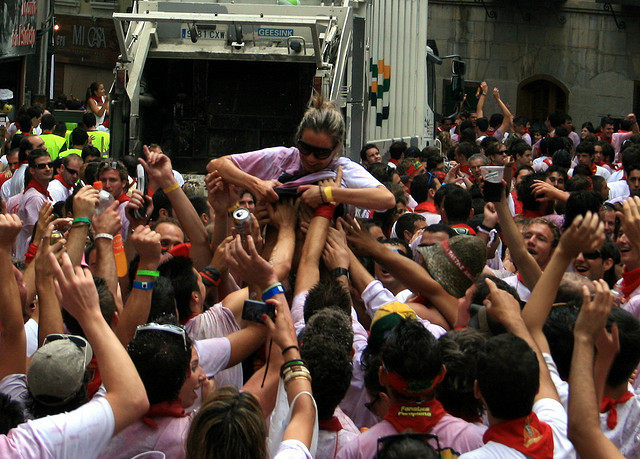
At San Fermin, the 'Anything goes' mantra has led to an increase in sexual assaults.
Photo by Abeeeer
Sexually charged atmosphere
In recent years, the event has also taken a dive to the dirty, and I’m not talking about people falling on the ground. Ibitnews reveals that the Spanish police detained over 64 people for various offences, including sexual assault. Zurine Altable, spokeswoman for Pamplona’s Gora Irunea has accused the festival’s payoff line: At San Fermin, anything goes, for the rise in sexual offence. It would seem the bulls are not the only horny creatures that enter the town during the festival.
While it’s certainly fun for many involved, I feel that the crime and unnecessary deaths that emanate from the festival every year cannot be justified. And I haven’t even started talking about the case of animal cruelty.
Animal cruelty at the Running of the Bulls
The torture of bulls during the Fiesta really gets to me. Although the Miura bulls are the main source of entertainment, they are quickly dispatched after the Bull Run. As if making the animals run through a drunk crowd isn’t enough, the bulls are tormented and murdered by matadors every evening in the Plaza del Toros (bullring). A handful of lucky bulls are pardoned by the crowd. What kind of sadistic behaviour is this?
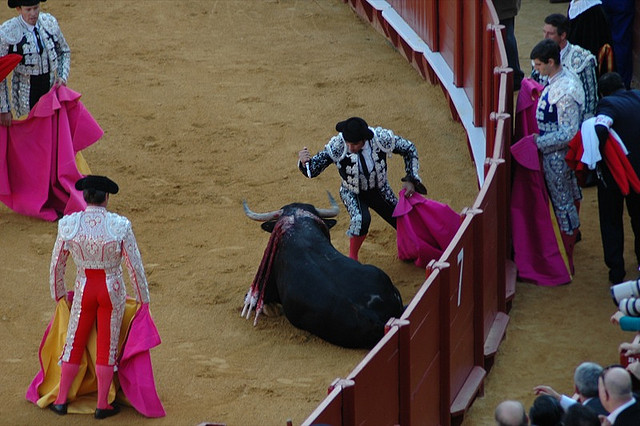
Every evening during the San Fermin Festival bullfights are staged.
Animal rights activist Dr Steven Best sums up this behaviour nicely. ‘By their own estimation, these moral misfits are having the time of their lives while helping to torture and kill bulls during the eight days of the San Fermin festival.’ ( read Barbarism in the Afternoon: Bullfighting, Violence, and the Crisis in Human Identity). How would you justify treating bulls as dangerous, gory beasts that should be used for human amusement before they are sent to the gallows? It’s impossible to hide behind tradition or culture when dealing with this one.
One Spanish journalist was caught by the BBC saying, ‘We are getting rid of so many traditions and things which bring people together that I think it would be a pity to get rid of the bull run.’ What a load of bullocks! People forget that tradition was created by humans who walked the planet before us, and there’s always an alternative to it. Slavery was a tradition too but that didn’t make it right. Why not create a tradition that values the fair treatment of animals? Supporters of this ‘tradition’ can munch on these words by Dr Samuel Johnson, ‘The antiquity of an abuse is not justification for its continuance.’
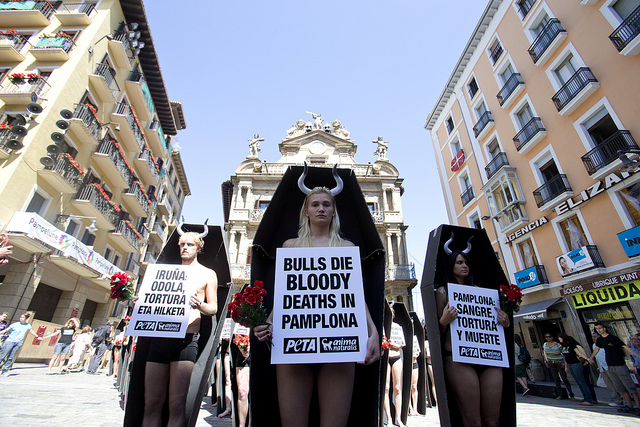
A PETA protest against the BullRun (Encierre).
Bloody money
According to USA Today, bullfighting pulls in 3,2 billion dollars into Spain and currently employs 10 000 people. There’s merchandise sellers, bull breeders and agents who benefit from this kind of cruelty. According to reports, Madrid’s annual San Isidro festival brings in more than 65 million dollars to the city during its 30 nights a year of bullfights. However, the extreme sport loots over 530 million euros of taxpayers’ money from the country per year (visit Bullfighting Free Europe). Why not invest that money in educating people about animal welfare?
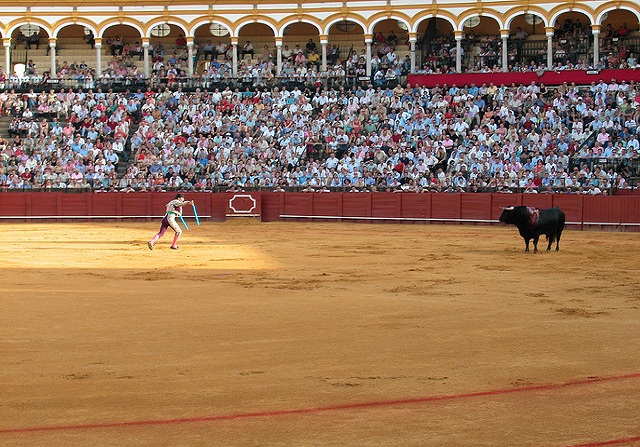
Crowds gather at plaza del toros all over Spain to watch bullfights.
Photo by carbonfirefly
Although bullfighting and bullrunning enthusiasts claim it’s a favourite Spanish pastime, evidence points to the contrary. A study by Gullop shows that only 7 per cent of the country’s population is directly involved in it, meaning that large chunks of money remain in the hands of a few. 72 per cent of Spaniards are just not interested in watching sadists killing bulls. It’s not as popular as the minority make it out to be. And lastly, before you yell, “tourism”, research shows most tourists don’t go to Spain to watch bullfights or to run with the bulls and even if they do land up up in the plaza del toros, they never return. The bums on most seats at these ruthless gory spectacles belong to bullfight enthusiasts (source:Bullfight Free Europe).
Anyways, now that I have spewed on the white pants of bullfighting devotees, do I think people should travel to the festival? No, of course not. Especially if you believe in responsible tourism and travel. To the bull-torturers, I’ve waved my red cape, now come get me.
Videos: The Running of the Bulls (warning: The videos contain graphic content which might offend sensitive viewers)
Main image by Anindha Parthy
Do you think the Running of the Bulls should be banned or do you think it should be allowed to continue in the name of ‘tradition’?









